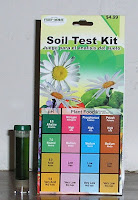Don't get scared off about soil tests and pH levels. This isn't rocket science--it's not even as hard as high school chemistry. pH is simply a measure of acidity and alkalinity using a scale that runs from 0 to 14. The midpoint, 7, is considered neutral. Below 7 all the way to 0 indicates increasing acidity. Above 7 up to 14 indicates increasing alkalinity (also called basicity). The soil pH level matters because essential nutrients in the soil are most available to plants when they are in the proper pH environment--with 5.5 to 6.5 being the most commonly appropriate range.
 Testing your soil's pH level is a simple and inexpensive process. I purchased a soil test kit produced by Ferry-Morse at my local hardware store for $4.99. The kit tests pH level as well as macronutrient levels (nitrogen, phosphorous, and potassium), which I'll test separately at a later date. For the pH test, all you have to do is take a small sample of soil from 4 inches below the soil line, put it in the test tube with the green cap, open the green capsule and pour the contents on top of the soil, then fill it with water, cap and shake, and let sit for a minute. Very quickly, the soil settles in the tube and the water on top of it turns a color that you can match to the color scale on the package.
Testing your soil's pH level is a simple and inexpensive process. I purchased a soil test kit produced by Ferry-Morse at my local hardware store for $4.99. The kit tests pH level as well as macronutrient levels (nitrogen, phosphorous, and potassium), which I'll test separately at a later date. For the pH test, all you have to do is take a small sample of soil from 4 inches below the soil line, put it in the test tube with the green cap, open the green capsule and pour the contents on top of the soil, then fill it with water, cap and shake, and let sit for a minute. Very quickly, the soil settles in the tube and the water on top of it turns a color that you can match to the color scale on the package. It doesn't show very well in this photo but my soil tested somewhere between 7.0 and 8.0, indicating that the soil is quite a bit more alkaline than the range that blueberries want (4.5 to 5.5). These simple home test kits don't give you a very exact reading, but it's enough to head you in the right direction in terms of how to amend your soil. If you want a more exact reading, check out the standard soil test you can have done by mail at the University of Massachusettts for only
It doesn't show very well in this photo but my soil tested somewhere between 7.0 and 8.0, indicating that the soil is quite a bit more alkaline than the range that blueberries want (4.5 to 5.5). These simple home test kits don't give you a very exact reading, but it's enough to head you in the right direction in terms of how to amend your soil. If you want a more exact reading, check out the standard soil test you can have done by mail at the University of Massachusettts for only Most edibles prefer somewhat acidic soil. Here's a sample of some of the acid-loving fruits and veggies you may be growing that might need some tweaking of their soil pH:
Avocados--6.0-6.5
Bananas--5.5-6.5
Blueberries--4.5-5.5
Brambleberries--6.0-6.5
Brussels sprouts--5.5-6.5
Citrus--6.0-7.5
Guava--5.0-7.0
Kiwi--5.0-6.5
Melons--6.0-6.5
Pomegranate--5.5-7.0
Potatoes--5.0-6.0
Rhubarb--6.0-6.8
Strawberries--5.5-6.5
Sweet potatoes--5.0-6.5
Turnips--5.0-6.5
In addition, ornamentals such as roses, azaleas, rhododendrons, camellias, begonias, and most bulbs are just a few of the flowers that like acidic soil.
So once you determine your pH level, what do you do? If you need to make your soil more alkaline (or basic), the amendments that are most commonly added are agricultural lime and wood ash. If you need to make your soil more acidic, most people add peat, but pine needles, pine sawdust, and coffee grounds will also do the trick. It takes time to measurably adjust the pH level of your soil, but providing the right pH environment should make a noticeable difference in the health of your plants and the harvest that results.
Tweet Pin It

No comments:
Post a Comment
Note: Only a member of this blog may post a comment.